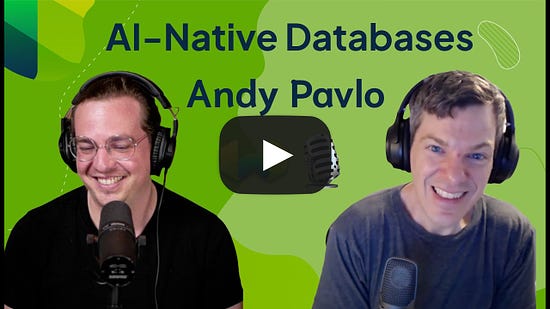The $100B Database Market Is on Track to Surpass 1,000 DBMSsCarnegie Mellon professor calls it the golden age of databases
Welcome to the Cloud Database Report. I’m John Foley, a long-time tech journalist who worked in strategic comms at Oracle, IBM, and MongoDB. If you received this newsletter, you’re a subscriber (thank you!) or someone forwarded it to you. This blog and free newsletter are independent, unsponsored, and not affiliated with my current role as a VP at Method Communications. Hello friends and welcome new subscribers! I hope 2024 is off to a great start for you. I just listened to an interesting podcast with Andy Pavlo, associate professor of databaseology at Carnegie Mellon University, in which Pavlo explained to Weaviate CEO Bob van Luijt why he thinks we’re in “the golden age of databases.” That’s a remarkable statement for a software platform that is 50 years old, yet one that continues to advance and evolve with new capabilities such as vector search, which is Weaviate’s forte. Pavlo points to the fact that there are now nearly 1,000 different database management systems in various stages of maturity (some old, some new) as evidence of thriving innovation. Pavlo’s Database of Databases includes stalwarts like Oracle, PostgreSQL, MySQL, MongoDB, SQL Server, and Redis, as well as newer ones like AwaDB, PuffinDB, and CloudBerry. (Tip: Click the “New in 2023” button to see the latest.) I recommend this podcast as an easy listen on the state of the database market heading into what’s sure to be another busy year. The conversation starts with the basics—Pavlo defines what a database is—and wraps up with his best guess on the next potential breakthroughs.  Stonebraker’s at it againSpeaking of what’s next, database pioneer Michael Stonebraker is working with researchers from Stanford and others on a project to develop a database-oriented operating system. Stonebraker’s startup company, DBOS Inc., describes it this way: “DBOS is a new multi-node OS built on a DBMS foundation for today’s cloud-native applications. It replaces 35 year-old Linux, and eliminates the need for container, DBMS, orchestration, and observability layers to enable cloud-native performance.” Or simply: “Run the OS on the database, not the other way around.” The sought-after benefits include security, simplicity, scalability, and speed of development. DBOS Inc. plans to begin offering its cloud service early this year. You can read more about it on the company’s website, DBOS.dev. Tech reporter Lindsay Clark interviewed Stonebraker and describes the project in The . The 80-year-old Dr. Stonebraker, who is co-founder and CTO of DBOS Inc., is well known in the database market. He was involved in the development of the relational database at UC Berkeley in the early 1970’s, and he was a leading force behind the Ingres, PostgreSQL, Illustra, and Vertica databases, among others. 8 Leaders in Gartner MQWho are the leading cloud database vendors? According to Gartner’s Magic Quadrant for Cloud Database Management Systems for 2023, they are (in alphabetical order) Alibaba, AWS, Databricks, Google Cloud, Microsoft, MongoDB, Oracle, and Snowflake. Companies that fell just outside of the Leaders quadrant include IBM, SAP, and Teradata. I don’t put too much weight on Gartner’s rankings because it’s unclear which vendors are paying clients of the research company. Gartner insists on its objectivity. For the record, here is Gartner’s policy on independent research. Is Aurora Serverless v2 really serverless?I have two updates to share on AWS database services. First, AWS has made it easier to migrate self-managed DB2 databases to its managed RDS for DB2 cloud service. You can find more info on its new Database Migration Service for DB2 here. And second, there’s an interesting article in InfoQ about a change in AWS’s Aurora Serverless cloud offering that seems to be riling up some users. According to InfoQ, the ability to “scale down to zero” may be lost when Amazon Aurora Serverless v1 is phased out at the end of this year. I say scale down to zero may be lost because I haven’t seen actual AWS documentation to confirm that. If this turns out to be wrong, I will run a clarification. But here’s the background: AWS announced GA of Amazon Aurora Serverless v2 in April 2022. More recently, AWS notified customers that Aurora Serverless v1 will be discontinued as of Dec. 31, 2024. That prompted disgruntlement among some customers due to the fact that that v2 apparently requires a minimum configuration of 0.5 Aurora Capacity Units (ACUs). In other words, it doesn’t ratchet all the way down to zero ACUs. Some users interpret this to mean that v2 isn’t truly “serverless.” And while this may seem like splitting hairs, there is apparently a nominal fee involved of about $35 per month. You can read more on the Reddit thread here. Further readingSay hello to another database startup, Tembo Data Systems. Paul Gillin profiles the Postgres startup in SiliconAngle. And finally, there were about 800 DBMSs in the world when I talked to Carnegie Mellon professor Andy Pavlo in 2022. Today, the tally stands at 960 databases and growing. By one estimate, the database market last year reached $100 billion in revenue. The golden age of databases, indeed. As someone who has followed the database industry for 25+ years, it sometimes feels like I’ve seen it all: Adabase, Aurora, Bigtable, BigQuery, Greenplum, Cloudera, Cockroach, Couchbase, DB2, DataSta… 2 years ago · 2 likes · John Foley Thank you for reading Cloud Database Report. This post is public so feel free to share it. © 2024 John Foley |
ERP documents are collection from various sources. We don't create them. They are created and owned by mentioned respective authors.
Document Authors: No copyright infringement intended. If you want us to add / remove this content, please let us know by writing to goodreads @ onlyerp dot com
The $100B Database Market Is on Track to Surpass 1,000 DBMSs
The $100B Database Market Is on Track to Surpass 1,000 DBMSs


Carnegie Mellon professor calls it the golden age of databases


